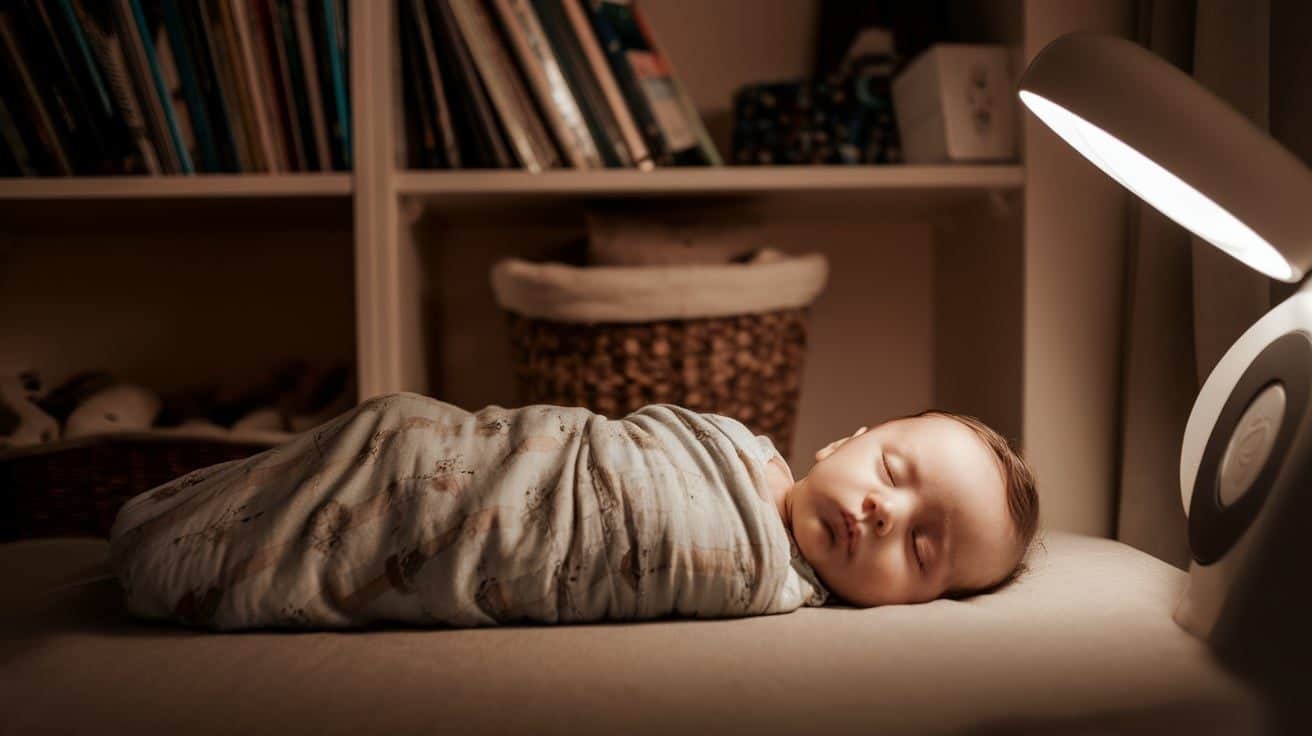If you’re anything like me, you’ve probably wondered why does my 6-month-old won’t nap longer than 30 minutes, especially when you’re hoping for a nice, long rest.
So, why does your 6-month-old only nap for 30 minutes? It’s a common struggle, and trust me, you’re not alone in this!
Around this age, babies grow and develop rapidly, and their sleep patterns are still evolving.
That means nap time can be a bit of a rollercoaster ride. But don’t worry; there are a few reasons why this might be happening, and there are even some tricks to help your baby get those longer, more restful naps.
Stick with me, and let’s get into why those short naps are happening and what you can do about it!
How Much Sleep Does a 6-Month-Old Need?

At 6 months old, your baby needs 12 to 15 hours of total sleep daily to support its rapid growth and development. This typically consists of 10-12 hours of nighttime sleep and 2-3 daytime naps totaling 2-4 hours.
While every baby is unique, most 6-month-olds follow a pattern of three naps a day, each lasting about 1-2 hours.
However, don’t worry if your little one’s sleep schedule looks a bit different – what matters most is the total quality of sleep they get in 24 hours.
Signs If Your 6-Month-Old Baby Is Getting Enough Sleep
Here are the signs of a well-rested baby:
- Wakes up with bright eyes and a possible morning smile
- Engages happily during playtime, interacting with toys and you
- Shows alertness and interest in food during mealtime
- Can go between naps without meltdowns
- Has clear, bright eyes when awake
- Hits developmental milestones with energy and enthusiasm
Remember, even the happiest babies can have off days!
What Are Your Baby’s Sleep Patterns Throughout the Day?
Think of your baby’s sleep schedule as a puzzle, with each piece fitting perfectly into their day. By 6 months, most babies do well with 2-3 naps, adding up to 3-4 hours of daytime sleep.
Their first nap typically comes about 2-3 hours after they wake up in the morning, and the second nap follows about 2-3 hours after they wake from the first.
Nighttime sleep is the biggest puzzle—aiming for 10-12 hours of restful sleep, though a feeding or two during the night is completely normal!
Some babies enjoy a quick third nap in the late afternoon, while others are fine with two longer naps.
Finding the rhythm that feels just right for your little one is the key. Just like adults have their sleep preferences, babies have unique sleep patterns, too!
Reasons for Short Naps in Your 6-Month-Old Baby
At 6 months, your baby’s sleep patterns are still evolving, and shorter naps are common. While it might feel frustrating, there are a few key reasons behind those quick 30-minute naps, many of which are normal as your baby grows.
Let’s break down the main reasons so you can understand what’s going on and how to help.
Developmental Changes in 6 Months Babies
At 6 months, your little one is growing fast and picking up exciting new skills like rolling over and sitting up. While this is all super exciting, it can also make them restless, affecting their sleep.
Their brain is busy processing all these changes, so don’t be surprised if they wake up more often after naps. It’s normal!
This stage of development can be challenging, but remember, it’s just a phase. Your baby will eventually adjust to their new routine, and those peaceful naps will come back before you know it.
Sleep Cycle Shifts and Transitions Of 6 Months Babies
At around 6 months, your baby’s sleep starts to resemble an adult’s, with light and deep stages. During these lighter stages, they might wake up, leading to those short, 30-minute naps.
It’s normal! As they grow, they’ll transition more smoothly between these sleep cycles. Before you know it, those little naps will stretch into longer, more restful ones.
This is all part of their natural sleep development, so hang in there – longer naps are on the way! Just give them time to adjust and grow.
How To Create The Right Nap Environment For Babies?
For a baby to sleep peacefully, it is best to make a dark, quiet room with a comfortable temperature so that they can sleep longer, and using blackout curtains and white noise can help. Here is what you can do
1. Make the Baby’s Room Dark and Quiet
- Aim to make your baby’s room as dark and quiet as possible
- Blackout curtains can work for blocking out sunlight
- A white noise machine or app can also help reduce household noises and lull your baby into a deeper sleep.
2. Keep a Comfortable Temperature For Babies
An ideal room temperature for infant sleep is between 68-72°F (20-22°C). Try to keep it this way.
When Babies are comfortable, they sleep more peacefully
So dress your baby in lightweight, breathable layers.
You can use sleep sacks or wearable blankets as they can’t kick them off like loose blankets.
3. Use a Safe and Cozy Sleep Space For The Baby
According to The American Academy of Pediatrics, if your baby sleeps in a bare crib or bassinet without any pillows, blankets, or toys, it can be at risk of suffocation.
Here is what you can do to make a safe, cozy area for babies to sleep:
- Make your baby sleep on a firm mattress or fitted sheets in a bassinet or crib.
- Avoid napping in car seats or swings.
- Using sleep sacks or wearable blankets can be a good option.
How to Create a Consistent Nap Routine for 6-Month-Old Baby?
Routines are best for babies. Creating a pre-nap routine and putting them down at the same time each day will make a routine and will help the baby sleep longer.
Follow a Predictable Nap Schedule For The Baby
Most 6-month-olds do well with a 2-3-4 schedule.
Wake time is 2 hours in the morning, 3 hours between the first and second naps, and 4 hours before bedtime.
Every Baby is different, so watch your child’s routines
If they seem tired after just 2 hours after the wake time, try putting them down then.
Create a Calm Pre-Nap Routine For The Baby
Creating a 5-10 mins soothing ritual can help babies feel relaxed and prepare them to sleep
Here are some activities you can try:
- Reading
- Singing
- Snuggling with lovey
- Massage
- Feeding before naps
Do it at the start of the routine so the baby doesn’t rely on it to fall asleep.
Watch for Sleep Cues Of The Baby
There are some signs you can see if your baby is ready to nap:
- Yawning
- Eye rubbing
- Looking glazed
- Fussiness.
Its best to put babies down drowsy but awake.
They will likely wake sooner if they are not tired enough to sleep.
How to Help Your 6-Month-Old Baby Take Longer Naps?
It is easy for babies to make habits of sleeping in your arms or your laps, but it would be helpful if you allow them to self-soothe back to sleep if they wake up early.
Help Your Baby Learn to Self-Soothe
- Don’t let your baby rely on feeding often; it can’t link sleep cycles to extended naps.
- Put your baby down awake to practice them falling asleep independently.
- You can gently pat or shush them if needed, but let them do their work of getting sleep.
Extend Short Naps Of Baby
If your baby sleeps less than an hour, try a quick 5-10-minute resettle without picking them up.
But, If your baby takes a 40-45 minute nap, consider a nap done, and if you want, adjust the bedtime earlier.
Adjust the Feeding and Wake Windows Of The Baby
If you want your baby to take good naps, it’s important to find the right balance of wake time to build up enough sleep pressure, but do not go to the point of overtiredness.
Please make sure they get full feedings after naps rather than snacking all day.
A satisfied tummy leads to a long sleep.
When To Seek Help For Your Baby
Even if, after using all the healthy sleep habits and still your baby’s sleep continues to be shorter, consult your pediatrician to rule out underlying issues.
Signs of Sleep Issues
Sometimes, If your baby is taking short naps, it can be a sign of an underlying issue like:
- Reflux
- Allergies
- Sleep apnea
You have to consult your pediatrician if your baby is
- Extremely fussy
- Not gaining weight
- Has concerning symptoms
But you don’t have to worry about it,
Some babies go through sleep regressions around this age too, usually these phases pass in 1-2 weeks.
When to Talk to a Pediatrician For Baby Naps Issues
If your little one is still having trouble sleeping, even after you’ve tried everything from healthy sleep habits to a consistent bedtime routine, it might be time to reach out to a pediatrician.
A pediatrician is a specialist who understands children’s sleep patterns and can provide expert advice tailored to your child’s needs.
They can offer practical tips, rule out any potential medical causes, and guide you through strategies that work best for your child’s age and development.
It’s always comforting to know that when you feel stuck, you have a trusted professional to help you navigate through it.
To Sum It Up
Managing your 6-month-old’s nap schedule is a journey, but trust me, it’s worth every bit of effort.
With a little patience and a few tweaks, you’ll be amazed at how quickly your baby’s sleep patterns can improve.
Remember, every baby is unique, and finding the right rhythm takes time—but when you do, it’ll make a world of difference for both of you.
As you work through the ups and downs, keep in mind that each step brings you closer to a solid routine. A well-rested baby means a happier, healthier little one.
Let’s not forget—you’ll feel better too! So, stay committed, enjoy the process, and know that you’re building a foundation for your baby’s growth and your own peace of mind. You’ve got this!
Frequently Asked Questions
Why Does My 6-Month-Old Won’t Nap Longer than 30 Minutes?
Six-month-old babies often take naps in short cycles. Factors like hunger, discomfort, or overtiredness may cause early waking. Regular routines can help extend naps.
How Can I Get My 6-Month-Old Nap Longer?
You can create a consistent nap routine, ensure a calm, dark environment, watch for sleep cues, and avoid overtiredness. Patience and regularity will help increase longer sleep.
Why Is My 6-Month-Old Not Sleeping Well Anymore?
Your 6-month-old might be going through a growth phase or sleep changes. Changes in routine, teething, or new skills can also affect sleep patterns.














